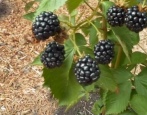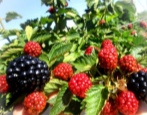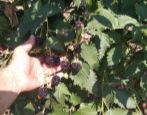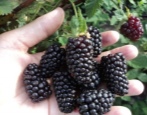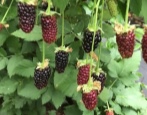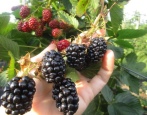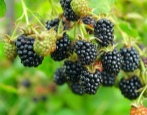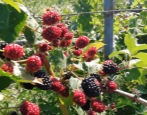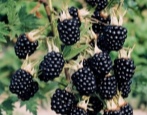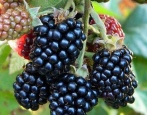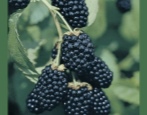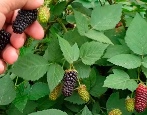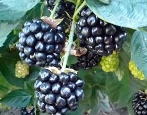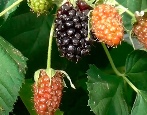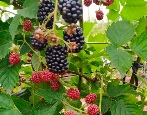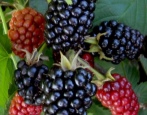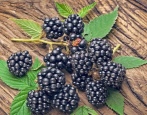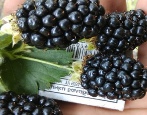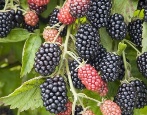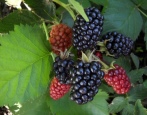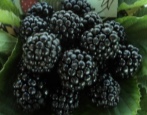
- Authors: Poland
- Taste: sweet and sour
- Scent : pronounced, blackberry
- The presence of thorns: No
- Tasting assessment: 4,5
- Berry weight, g: up to 11
- Berry size: large
- Berry color: deep black
- Fruiting period: July August September
- Yield: 5-6 kg per bush
Blackberries are not as popular as raspberries. But every year it wins the hearts of gardeners more and more, and the market - more and more. Lovers of black berries should take a closer look at the unpretentious fruitful Polar blackberry. A completely thornless hybrid was bred for industrial use, but spread to the plots of amateur gardeners.
Breeding history of the variety
The Polar blackberry was bred by Polish breeders of the Institute of Horticulture and Floriculture. It happened in 2008.
Description of the variety
Blackberry bushes Polar medium vigor. Height - up to 2.2 m. The root system is powerful, the roots spread to a depth of 1.5 m underground. Up to 12 powerful shoots can grow from each root. Polar does not give root offspring. This greatly facilitates the care of the berry.
Shoots are tough and thick, the upper part is slightly curved. There are no thorns on them. Scourges reach a length of 270 cm. Young branches are green and turn brown with age. The leaves are three-lobed, green. The buds are pinkish, and the blossoming petals are white on top, light pink below. The flowers are large. A large number of small black stamens. Blooming is observed in May.
The branches are usually strewn with mouth-watering berries that are versatile. You can eat fresh berries, freeze them, make delicious jam or preserves. Blackberry compote from Polara berries tastes a bit like raspberry.
High transportability. The berries do not flow, they keep their shape well. Can be transported over long distances. Stored well.
Ripening terms
Early ripening culture. Blackberries from the bush can be enjoyed for 3 months. The first berries can be picked in July. The main fruiting occurs in August, and it ends in September.
Growing regions
Moderate latitudes are best for cultivation. Suitable for breeding in the middle lane, as well as in the southern regions of Russia, Ukraine, Belarus.
Yield
The yield is high, the fruiting is stable. From one bush, you can collect 5-6 kg of blackberries. The maximum number of berries is harvested from plants that have reached the age of three.
Berries and their taste
The berries are large, their average weight is from 9 to 11 g. They are oval in shape. The surface is black, shiny, with a slight bluish bloom. Blackberries are sweet, with a very slight sourness. No toughness. The pulp is firm. Bones are not felt when eating. The aroma is pleasant, blackberry. The tasting score is 4.5 points, which indicates excellent taste. Overripe berries can fall off the branches.
Growing features
If there are a lot of berries, the shoots can bend strongly to the ground. Therefore, the bushes are recommended to be planted next to the stakes. Polar's bushes are tall and need a garter. Good performance is observed when grown on trellises.
The thickened planting does not affect the fruiting of Polar blackberries.
Site selection and soil preparation
For Polar blackberries, it is necessary to allocate a sunny place on the site. Lowlands are undesirable. Surface water tables should also be avoided.A place where drafts are walking will not work. It is better to choose a calm, well-warmed area by the sun.
Preference should be given to sandy or loamy soils. Acidic soils will not work. The soil should be neutral. Ash or lime is added if necessary.
Blackberries do not like the neighborhood of strawberries, raspberries, nightshade crops.
Bushes can be planted in spring or autumn. In the southern regions, it is better to plant in the autumn. Then in the spring the bushes will immediately start growing. And in the central, northern regions, spring planting of bushes is preferable, after the threat of frost has passed.
Pruning
It is necessary to prune the plant after fruiting. Two-year branches are pruned. On each bush, 4 to 7 lashes are left. Prophylactic pruning is carried out during the season.
Watering and feeding
The bushes have a well-formed root system, so Polar can grow for a long time without watering. But if dry weather sets in, it is necessary to water the blackberry. This will help avoid chopping the berries.
Watering is moderate, once a week. More frequent watering (1 time in 4 days) is needed after planting.
In the spring, fertilizers containing nitrogen are used. During flowering, you can feed with complex mineral fertilizers. At the end of the season, potash fertilizers are applied. This will facilitate the establishment of generative buds.
Blackberry Polar is able to do without feeding at all.
Frost resistance and preparation for winter
Polar is very frost-hardy, winter-hardy. Withstands 25-degree frosts. But it is still recommended to cover the bushes. The spring sun can burn whips. Shelters are also necessary if in the region the thermometer in the growing region drops below -25 degrees. Flower buds can be affected by frost. The yield will be greatly reduced because of this.
Diseases and pests
As a rule, pests and diseases do not affect Polar blackberries. It has good immunity to most viral and fungal diseases.
Reproduction
Since Polar practically does not produce root suckers, it may be difficult to reproduce. The method of pulping is used - the rooting of the tops of the shoots. To do this, the top of the young shoot is cut by 2.5-3 cm. The leaves are cut, stepping back 10 cm. The shoot is tilted into the dug shallow furrow. Sprinkle with earth in the place where the foliage was cut off. It is necessary to ensure that the soil in this place is moist. Rooting is best done in early August. The next year, the rooted fry must be separated from the mother bush and transplanted.
Review overview
Summer residents who grow Polar on their site note its unpretentiousness, unique disease resistance, excellent taste of berries.
The disadvantages of the plant include the fact that it is difficult to cover it. Shoots are thick and tough and difficult to tilt. Therefore, it is recommended to carry out a garter of young shoots.


